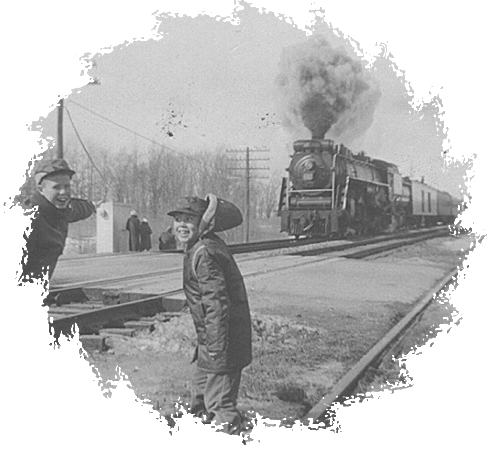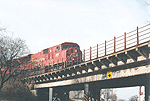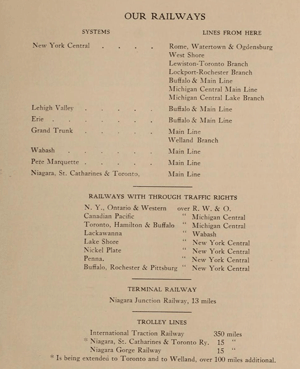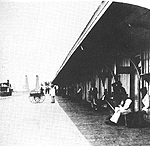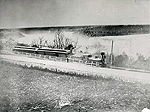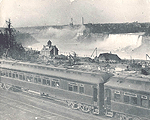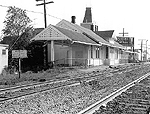Niagara Falls owes an everlasting part of its heritage based upon the development and advancement of railroad transportation. Railways have made the Niagara Frontier more accessible. This has allowed the fullest potential of Niagara Falls for tourism, power, and industrial purposes to be realized. Small settlements soon appeared near these new railways. People of many nationalities came to Niagara to work and to live. These important elements have fuelled the growth of technology and commerce that has allowed Niagara Falls to develop and prosper. Railroad history in Niagara Falls has been indelibly weaved into the fabric of our community. This history continues to evolve.
NIAGARA
FALLS RAILROAD
Buffalo & Niagara Falls Railroad Niagara Falls & Lake Ontario Railroad
STATION &
BUILDINGS
Niagara Falls New York Railway Stations
Great
Western Railroad
In 1834, a charter for the London & Gore Railroad was granted. It was given for the purposes of constructing a single or double wooden or iron railway from London to Burlington Bay. Power for this railway was by animal or by steam. In 1845, a grant was given for the London & Gore Railway to expand its rail line to the Detroit River. The name of the railroad was changed to the Great Western Railroad. The Great Western Railroad became the first railway across southern Ontario. In 1848, the first suspension bridge was constructed at the foot of Bridge Street. A settlement grew up around the Canadian terminus of this bridge. This became known as the Village of Elgin in honour of lord Elgin, the then Governor General of Canada. A similar settlement sprung up around this bridge on the American side. This settlement became known as the Village of Bellevue. In 1849, a grant was given to extend the Great Western Railway to Niagara Falls. Aside from a sod turning ceremony and a dinner, nothing took place until 1851 when construction began. The contractor was Samuel Zimmerman. Service between Hamilton and Niagara Falls began in November of 1853. The first steam engine was the “Great Western”. During the maiden trip the rail bed gave way approximately six miles from Niagara Falls stopping the train from proceeding any further. Passengers had to complete the journey by road. With this extension, the Great Western Railroad was now in a position to connect its rail line from Canada into the Unites States of America. In order to connect this railroad to the American shore, the Great Western Railroad had to build a bridge to span the Niagara River Gorge. On March 8th 1855, the first locomotive named "London" crossed the bridge. It was one of the largest engines of its time, weighing twenty-three (23) tons. It crossed at a speed of eight (8) miles per hour (mph) and caused a deflection of only three and one half inches at the center of the span. This new railway bridge gave the Great Western Railroad a direct connection to New York. In 1856, the Villages of Clifton and Elgin were amalgamated to become the Town of Clifton. Samuel Zimmerman died on March 12th 1857 in the Desjardins Canal Railway accident. He had been in Toronto during the day and was returning home by train at the time the train derailed and plunged into the canal. He and 58 other persons died. The Town of Clifton was developing into a sizable border railway town. In 1881, the Town of Clifton became the City of Niagara Falls. In 1884, the Great Western Railroad became known as the Grand Trunk Railroad. In 1923, the Grand Trunk Railroad was purchased by the Canadian National Railroad.
Bridge Street Railway
Station (Clifton Railway Station) -1863
In 1855, the Great Western Railroad completed building a passenger deck at the site of its future depot. The Great Western Railroad built a train station named “Clifton”. It was built at the foot of Bridge Street (on the site of the current train station). At the time the Town of Clifton had of population of less than 1,200 citizens. The first passenger depot existed for only 16 years before it was destroyed by fire in the spring of 1879. The Great Western Railroad immediately rebuilt the depot. In 1879, a replacement train passenger depot was built of red brick in a gothic architectural style. It had a two storey centre section and a 100 foot long eastern and western wings branching off of the centre section. Prior to 1951, the two waiting rooms were accessed through separate entrances. Until 1951, women and men had separate waiting rooms. The stations had 15 foot high ceiling and wood plank flooring. A centre circular ticket booth served both waiting rooms and a huge pot bellied stove supplied heat to both of them. The baggage rooms were located at the end of the western wing. Between 1853 and 1860, the station contained a restaurant/saloon which was operated by M. Kavanagh. Liquor was sold at the restaurant as refreshment. The restaurant was known as the “Great Western Restaurant”. In 1860, this restaurant/saloon was operated by the Bampfield family. The Bampfield family continued to operate this restaurant until 1909 when the liquor license for this business was revoked. This train depot led to the building of many area hotels and motels. In 1967, Canadian National Railway took off 80 feet from the eastern wing of this train station in a cost cutting move. In addition, the stairway to the second floor was removed. Today, access to this vacant second floor can be gained only by use of a ladder. In 1976, a similar cut was planned for the western wing however this plan was subsequently scrapped. This station is the current railway station located on Bridge Street and is one of the oldest in the Province of Ontario.
In 1857, the Great Western Railroad built a railway roundhouse to be used for repairs and maintenance of the locomotive trains. The roundhouse contained twenty-four (24) stalls. The roundhouse was located near the north east corner of the railroad property near the current area of River Road and Buttrey Street. In 1960, eighteen (18) of the roundhouse stalls were demolished. In July of 1968, roundhouse was closed by the Canadian National Railway as part of Canadian National’s program to consolidate diesel locomotive maintenance and repair operations. Ten workers were to be relocated. The roundhouse had been built to repair steam locomotives. As the switch was made to diesel, repair operations at the Bridge Street Roundhouse became redundant. The roundhouse existed for 118 years before being demolished in November of 1971. The roundhouse turntable was sent to Attica, New York.
In 1880, the Wabash Railroad built a long one storey freight shed just west of the train passenger depot. The freight sheds stood until being demolished in the late 1950’s.
In 1923, Canadian National Railway built an express office between the train station and the freight shed. In June of 1948, a derailed locomotive ploughed into the express office totally destroying it. The Express Office was rebuilt and stood until 1967 when it was demolished at the same time the train station was downsized.
Erie & Ontario Railroad
the Canadian Southern Railroad at Falls View in
1879
In the early 1830’s one of the first settlements along the western banks of the Niagara River was the Village of Clifton. In 1831, the Village of Drummondville became the first organized settlement in Niagara. In 1831, the new Welland Canal built under the direction of William Hamilton Merritt was completed. As a result of this new mode of transportation, business along the Portage Road dwindled putting many out of work. In order to compete with the canal, the businessmen of the Portage Road formed the Erie & Ontario Railroad Company. In 1831, a group of businessmen formed a company to build a railroad between Chippawa and Queenston. They applied for a charter. These charter members were: Alexander Hamilton, John Hamilton, Thomas Clark, Robert Grant, David Thorburn, Humphrey J. Tench, James Cummings, Samuel Street and Malcolm Laing. William Hamilton Merritt, a member of the Provincial Legislature opposed the application. Merritt a driving force of the new Welland Canal didn’t want any alternative forms of transportation which could amount to competition for the successful canal trade. The original application for a charter to form the Erie & Ontario Railroad Company was turned down by the Provincial Legislature in 1832 and 1833. On April 16th 1835, the Erie & Ontario Railroad Company received a government charter to begin operation. Construction soon began on their railroad. It would be the first railroad in Canada. Shares were sold to help finance this endeavour. The shares became known as the Queenston - Chippawa Railway. At a general meeting on September 7th 1835, civil engineer, James Archibald of Luzerne, Pennsylvania was awarded the contract to build this railroad. The railway was completed within five years after construction had begun. By 1839, an electric rail line was operating between Chippawa and the Falls. This railroad became known as the Queenston - Chippawa Railroad. This line paralleled the Niagara River Gorge and would later become part of the famous belt line or Great Gorge Trip route. In 1844, the steamboat "Emerald" provided daily trips for railroad passengers between Chippawa and Buffalo. On July 3rd 1845, the Erie & Ontario Railroad began operations from Chippawa to Niagara. Using an original track gauge of 5’6”, the railroad shared track from Stamford to Clifton along with the Great Western Railroad (Canadian National Railroad). Cars carrying passengers were being wheeled around by a team of three horses along a wooden roadway. The rails were constructed of wood with a length of strap or band iron covering the top of the rail to prevent excessive wear. Passenger carriages were drawn by horses hitched in tandems. The carriages were box like compartments with doors on each side along with running boards to allow easier access. The seats ran across and each carriage had room for about 20 passengers. Luggage was carried on the roof and the driver had an outside seat at roof level. The carriage had four wheels and was pulled along at 5 miles per hour (mph). The Queenston terminus of the new railroad ended near Brock’s Monument because the horses couldn’t pull the railcars up the steep grade of the escarpment. A wharf was built at Queenston along the rivers edge. Passengers arriving by lake steamers were transported in horse drawn carriages to the rail depot which was located at the north-east corner of what is today York Road at Front Street. From the Queenston depot, the rail line ran west along the Southside of the current York Road as it began a gentle climb up the side of the Niagara Escarpment. The grade was designed at 3 – 5 degrees. At the top of the escarpment, the railway turned southward cutting through what is currently the Queenston Quarry and followed a pathway southward along the Westside of Concession 2 (Stanley Avenue). At the intersection of Concession 2 (Stanley Avenue) at Portage Road, passengers had to disembark from the railcars until the horse teams could be changed. The team of three horses used to pull the railcars up the escarpment were switched for a fresh team consisting of one or two horses to continue the remainder of the journey. This stop over became known as the Stamford Halfway. It wasn’t the halfway point in distance but rather the halfway point of the energy the horses pulling the railcars had expended. The terrain of the remainder of the rail line south of Stamford Halfway was generally flat and required much less than the initial three horse team. A small settlement sprung up at the Stamford Halfway intersection. The businesses included a tavern called the “Halfway House”, a bakery, a general store and a blacksmith shop. The rail line continued southward until it reached the current Thorold Stone Road. Here the rail line turned south-east and followed the continuation of Concession 2 (Stanley Avenue) through a forest near the current Bridge Street to Valleyway. At the site of Valleyway was the Muddy Run Creek. A train bridge was built to allow the railroad to cross over the creek. The next stop occurred on Concession 2 (Stanley Avenue) at Ferry Road (Ferry Street). This was the rail depot owned by Lanty McGilly. Here passengers destined for the USA would disembark and would transfer to a stagecoach which would take them to the Maid of the Mist dock. The Railroad Hotel was built on the north-west corner to cater to the railroad passengers (Current site of Napoli Pizzeria). It was owned and operated by Adam Fralick. The Railroad Inn was demolished in the mid 1940’s. The railroad followed the high bank (top of the moraine) southward along the Falls View area. Here the railroad crossed another bridge over the Murray Hill ravine (just east of the current Canadian Pacific Railway crossing). The railway followed a general path along the current Canadian Pacific Railroad line. The train stopped at the Pavilion Hotel to allow passengers to get on or off. As the railroad continued south to Chippawa it again followed the high bank past Clark Hill (now Oak Hall). The Chippawa terminal was located at the dock along the Chippawa Creek (current site of Front Street at Norton Street). Here steamboats from Buffalo brought daily passengers to Niagara Falls. Passengers wanting to get on or off could do so at designated stopping area. They included the Chippawa terminal, City of the Falls (Falls View), the Railroad Inn at Ferry Street and Queenston. This railroad could not operate during the winter. This coincided with the cancellation of steamboat services for the season. This railroad became known as the Erie and Ontario Railroad Coach. In 1852, the Erie & Ontario Railroad applied for and was granted a revision to its charter allowing for a change to steam power. Early train locomotives got about 36 miles for each cord of wood burned. This was later improved to 50 miles for each cord of wood burned. In 1853, modernization of the Erie & Ontario Railway necessitated the relocation of its tracks from bush lands located west of Stanley Street to pass through the new centers of the settlements. This relocation resulted in the Erie & Ontario Railway passing much closer to the Niagara River from Chippawa to Clifton. The track relocation was unanimously approved by the Town of Clifton council, who in their great desire to have this rail service pass through the center of their communities, granted the railway all sorts of concessions. They relocated entire streets in the center of the village to accommodate the new railway. More importantly it provided an easy transportation link for the many passengers wishing to visit Niagara Falls. The original railroad was rebuilt for steam operation using a narrower rail gauge. The route was changed to provide for a gentler grade at Queenston and to be located closer to the Railway Suspension Bridge in Niagara Falls. Samuel Zimmerman of Clifton took over financial control over the Erie & Ontario Railroad. Zimmerman was the rich financier and contractor who brought the Great Western Railroad to Niagara. Zimmerman began by infusing much money into extending the rail line to Niagara (Niagara on the Lake). The newly relocated railroad line followed a path very close to the current Canadian Pacific Railroad. The rail line changed direction at the intersection of Huron Street and followed a route to Park Street. Here, the rail line ran westerly along the north side of the street. The new Erie & Ontario rail line ended at Victoria Avenue at Bridge Street where it joined with the existing Great Western Railroad.
In 1854, the Erie & Ontario Railroad extended its service northward from Queenston to Niagara on the Lake. This extension allowed the railroad to connect to an already established Lake Ontario steamer service docking at Niagara on the Lake. The Erie & Ontario Railroad followed the Great Western Railway for 2 miles until reaching St. David’s. At this point, the Erie & Ontario Railroad branched off and followed a path down the escarpment via the St. David’s Hill on a gentle grade eastward to Queenston. A mile west of Queenston, opposite the current Niagara Township Concession 2 road, the Erie & Ontario Railroad crossed the current York Road by bridge. The southern abutment of this bridge still exists today. The rail line generally followed the 2nd Concession northward to Queenston. On Saturday September 24th 1853, while the Chippawa - Queenston horse cars were crossing the St. Catharines Suspension Bridge Road, a loose hitch pin caused the car to run off the road. One lady sustained a fractured collar. In 1854, the Great Western Railroad proposed to buy the Erie & Ontario Railway but their share holders did not approve. In 1856, the Villages of Clifton and Elgin were amalgamated to become the Town of Clifton. Samuel Zimmerman died on March 12th 1857 in the Desjardins Canal Railway accident. Zimmerman’s financial empire collapsed as did his financial support for the Erie & Ontario Railroad. Following Zimmerman’s death, the Erie & Ontario Railroad changed its name to the Fort Erie Railroad Company. In 1859, coal began replacing wood as a fuel source for stoking the locomotives. In 1862, the Fort Erie Railroad Company was purchased by William Thompson. In 1863, the company became known as the Erie & Niagara Railroad. In 1864, the Erie & Niagara Railway was extended southward from Chippawa to the Fort Erie ferry dock. From here, the Railroad provided passenger service to the many crossing passengers crossing the Niagara River by ferry boat from Buffalo. The Buffalo-Fort Erie ferry boat service continued until 1873, when the International Railway Bridge spanning the upper Niagara River between Buffalo and Fort Erie was built. In 1864, conductor Patrick “Paddy” Miles joined the Erie & Ontario Railway. Paddy Miles was such a popular conductor that soon the train on which Miles worked became affectionately known as the “Paddy Miles Express”. In 1864, there was one train trip per day running from Buffalo to Niagara on the Lake. The train would leave Buffalo at 7 a.m. and would arrive at Niagara on the Lake by noon. A return trip was made beginning at 2 p.m. arriving back in Buffalo at 7 p.m. The steam driven locomotive had a diamond shape smoke stack and was equipped with a wood burning engine, which required the train to frequently stop for wood and water. In 1869, the Erie & Ontario Railroad became the Niagara division of the Canadian Southern Railroad. In order to access the American market, The Canadian Southern Railroad formed a partnership with the Michigan Central Railroad in order to do so. The Canadian Southern Railroad had a rental agreement with the Great Western Railroad to use their rail line and to cross their railway suspension bridge at the Niagara border. In 1871, the Niagara Military Camp was established along the shores of the Niagara River at Niagara Falls. The “Paddy Miles” rail line was used to transport troops, supplies, and tourists alike. The train consisted of one small steam locomotive with a wood or coal tender car. The train pulled one passenger car and one baggage car. In 1873, the Canadian Southern Railroad was running three trains per day between Fort Erie and Niagara on the Lake.
In 1871, the Canadian Southern Railway began operating trains through Niagara Falls. Company Superintendent, Mr. Cornelius Sheeky was at Niagara Falls with a photographer looking for places from which to take publicity pictures, when he saw Loretto Academy on the high ground above the railroad tracks. Mr. Sheeky and the photographer went to Loretto Academy and with permission of the nuns, he took pictures from the building cupola. The view of the Falls from this location was unparalleled. Mr. Sheeky decided he would stop every Canadian Southern Railroad passenger train just below Loretto Academy in order to allow his passengers to view the beauty of the Falls before continuing their journey. Mr. Sheeky enrolled his daughter at the academy. The Canadian Southern Railway began advertising the Falls View and all day trains were stopped 15-20 minutes at this location for sightseeing purposes. Fast trains were stopped for 5 minutes before continuing. It began a practise of making a short stopover at the Falls View area to allow passengers a panoramic view of the Falls of Niagara. In 1878, the Erie & Niagara Railroad became part of the Canadian Southern Railway. The Canadian Southern Railroad built two railway stations along its route in Niagara Falls. The main station was called the “Clifton Station”. It was a large two storey train station located on Queen Street at Park Street (the parking lot of the former Rosberg’s Department Store). The second station was the “Niagara Falls Station” but became known as the famous “Victoria Park Station”. It was located at the top of Ferry Hill (Clifton Hill). From 1880 to 1920’s, at least three steam boats plied Lake Ontario between Niagara and Toronto. Six passenger trains per day were running along the Erie & Ontario Rail line carrying passengers and freight from the Niagara docks. By 1882, the financial cost to cross the Canada-USA border using the Great Western Railroad suspension bridge was too excessive for the financially strapped Canadian Southern Railroad. By agreement, the assets of the Canadian Southern Railroad was taken over by the Michigan Central Railroad. The Michigan Central Railway had leased the railway for twenty-one (21) years. Before the original lease expired, the Michigan Central Railway renewed its lease for use of the rail line for 999 more years. This lease still exists today although many changes of ownership have taken place. In 1883, the Michigan Central Railway built a double track from Welland to Niagara Falls where it connected to the Grand Trunk Railway (formerly Great Western Railway) in order to provide passenger train service to the USA via the GTR’s International Suspension Train Bridge at the base of Bridge Street. A dispute over the use of the Grand Trunk Railway Bridge by the Michigan Central Railway ensued. This directly resulted in the Michigan Central Railway building the International Railway Bridge spanning the Niagara River Gorge just south of the Grand trunk Railroad Bridge. The first
Michigan Central Railway Bridge was located just South of the Whirlpool
Bridge and was built for rail traffic only. Mr. Vanderbilt owned the Michigan Central Railway and had controlling interest in the Canadian Southern Railway. In lieu of paying rent, he decided to build a new bridge. Vanderbilt formed the Niagara River Bridge Company and received a charter to build a new bridge. The new bridge a steel cantilever design which became known as the Michigan Central Railroad Bridge. On December 1st 1883, the bridge was completed. In 1883, the rail bed of the Michigan Central Railway leading to the new bridge followed a route that brought the tracks past the front (east side) of Loretto Academy. This resulted in a portion of the original Portage Road in that area to be closed to accommodate the Michigan Central Railroad. Despite many protests, the council of Stamford Township approved this road re-alignment. This portion of Portage Road was routed to follow Stanley Street to McLeod Road. All Michigan Central Railroad trains stopped at Falls View for at least 10 minutes to allow everyone to view the majestic Falls of Niagara. The Michigan Central Railroad built two additional train depots: the Falls View Station and the Wesley Park Station.
The Paddy Miles rail line was still using the Michigan Central Railway tracks as well. Train conductor Paddy Miles continued to work on the railroad until 1902. Patrick Miles finally retired after 48 years of service. Following his retirement, he sold wood and coal in Niagara on the Lake. The former Erie & Ontario rail line continued to operate until the mid 1920’s before passenger service was terminated. This rail line continued to function for freight train service until the rail line was closed completely in 1959. In 1925, the Michigan Central Railroad discontinued rail service from Fort Erie to Chippawa. In 1929, the New York Central Railroad leased the Michigan Central Railroad for 99 years. On January 2nd 1930 the New York Central Railroad began operations along the former Michigan Central Railway right of way through the center of Niagara Falls. In mid 1940’s the New York Central Railway tried to abandon this rail line to Niagara on the Lake however it remained in service until 1959. Although passenger service had ceased after 1926, only freight continued to be transported. In the late 1940’s until mid 1950’s, the St. Catharines Growers Co-op used the railway facilities located just east of St. David’s. Finally in 1959, the New York Central Railroad closed the rail line to Niagara on the Lake. The old St. David’s railway station was removed. On March 20th 1950, the New York Central Railroad roundhouse at Montrose Road was gutted by fire. Ironically, responding firemen had to wait 20 minutes for a train at the Stanley Street level crossing before they could get to the fire. On April 8th 1960, a rock slide along the Niagara Escarpment destroyed seventy feet of track belonging to the New York Central Railroad from St. David’s to Niagara on the Lake. In 1968 the New York Central Railroad was purchased by the Penn Central Railroad. On June 21st, 1970, the Penn Central Railroad went bankrupt. In 1976, the Conrail Railroad was established and began operations after acquiring the assets of the Penn Central Railway and a number of other railroads. In 1983, Canadian National and Canadian Pacific Railway purchased the Conrail system. For many years, the trains have rumbled through the center of the tourist core of the city along the former Michigan Central Railway right of way. Since that time the City of Niagara Falls officials have made repeated efforts in an attempt to relocate this railway line for safety and noise concerns without success. In 1965, rail relocation was estimated to cost $7.2 million dollars In 1970, rail relocation was estimated to cost $9 million dollars. In 1972, rail relocation was estimated to cost $10 million dollars. In July of 1972, the Chippawa Railway Station was being sold. It had been built in the early 1900’s and it was in use in 1910 when the Norton Abrasives Company opened. Centralization of rail freight handling services result in the closure of this station. Between 1999 and 2001, the City of Niagara Falls in association with the Province of Ontario and Casino Niagara (Falls Management Company) negotiated a purchase of this 10.6 kilometre (6.5 miles) long by 30 meters (100 feet) wide railway right of way from the Canadian Pacific Railroad for $39.5 million dollars. The cost of this purchase amounts to $1,136 per foot or $11.50 per square foot.
The Falls Management Company and the Province of Ontario will contribute $22.5 million dollars towards this purchase while the City of Niagara Falls will pay $18 million dollars. The deal was closed on December 19th 2001. All Canadian Pacific Railway trains are now being re-routed along the Canadian National Railway line crossing the Niagara River by use of the International Railway Bridge Buffalo to Fort Erie. Today, a stone cairn is located at the corner of Stanley Avenue and Morrison Street that commemorates the Erie & Ontario Railroad as the first railroad in Upper Canada and the 3rd in the Province of Ontario.
Victoria Park Railway
Station (Niagara Falls Railway Station) -1884
the Victoria Park Railway Station
The Victoria Park Railway Station was located at the top of Clifton Hill. It was one of the last original railway stations built in 1884-1885. It was one of four original passenger depots built along the Michigan Central Railway double track line from Montrose to Niagara Falls. The other three railway stations built were:
Falls
View Station The Victoria Park Station was the last to operate until the mid 1950’s before being sold and converted into a souvenir shop. The station was officially known as the Niagara Falls Depot and was the closest station to the Falls of Niagara. It later became known as the Victoria Park Station after Queen Victoria Park which was located nearby at the base of Clifton Hill. The Victoria Park Station was an elongated building. A waiting room occupied the southern end of the building. A ticket office and washrooms occupied the center section. A baggage room occupied the northern section of this depot. The waiting room was heated with a pot bellied stove. The baggage room was later transformed into a maintenance room. Citing declining passenger service, the Victoria Park Station was sold in 1956. The building was sold to Mr. Oscar McLeod. He converted the station in the “Top of the Hill Souvenir Store”. The New York Central Railroad continued to rent space in this former station. On August 12th 1943, Sir Winston Churchill arrived at Niagara Falls by train stopped at the Victoria Park Station for a thirty (30) minute visit of the Falls. In 1970, a “Sea-Aquarium” owned by Mr. George Martin housed in this building. Mr. Henry Mueller later purchased this building to house his Houdini Museum. The building was later destroyed by a fire. Today the former site of this railway station is occupied by the Ripley's Moving Theater attraction.
Clifton Railway Station (Niagara Falls Railway Station) -1884 The Clifton Depot was a two storey building which was located on Queen Street at Park Street (parking lot of the former Rosberg’s Department Store) built as the main train depot for the Canadian Southern Railroad. It was opened to the public on January 13th 1884. The Clifton Depot was demolished in 1941.
Falls View Railway Station - 1884
In 1871, the Canadian Southern Railway began operating trains through Niagara Falls. Company Superintendent, Mr. Cornelius Sheeky was at Niagara Falls with a photographer looking for places from which to take publicity pictures, when he saw Loretto Academy on the high ground above the railroad tracks. Mr. Sheeky and the photographer went to Loretto Academy and with permission of the nuns, he took pictures from the building cupola. The view of the Falls from this location was unparalleled. Mr. Sheeky decided he would stop every Canadian Southern Railroad passenger train just below Loretto Academy in order to allow his passengers to view the beauty of the Falls before continuing their journey. Mr. Sheeky enrolled his daughter at the academy. The Canadian Southern Railway began advertising the Falls View and all day trains were stopped 15-20 minutes at this location for sightseeing purposes. Fast trains were stopped for 5 minutes before continuing. The Michigan Central Railroad continued this practice. This practice continued until the mid 1920’s. It was stopped only for a brief period of time during World War I for security reasons. The Michigan Central Railway built a railway station at Falls View that resembled a six sided summer house with a single entrance. It contained bench type seats around the interior walls of the building. An excellent panoramic view of Falls of Niagara were available through the stations many windows. A concrete platform paralleled the tracks from which pedestrians stepped from the trains that stopped here. A large grassy area east of this platform and closest to the edge of the high bank provided an outdoor area for resting and viewing the Falls. Train ticket could not be purchased at the Falls View Station. It was just for resting and waiting until the train was ready to leave again. The Falls View Station and viewing area was known in railroad timetables as “Inspiration Point”. The Falls View Station was a popular landmark from the 1870’s through to the mid 1920’s when it was demolished. In 1885, the Michigan Central Railway was advertising that every train stopped at Falls View for 5-10 minutes. The Falls View Station was also being advertised for the first time as well. The Falls View Station was demolished between 1925 and 1926. The sidewalk, platform and grass rest area was maintained by the Michigan Central railway for another 8-9 years. In late 1934 and early 1935, Oakes Drive and the Stamford Bridge over the Michigan Central Railway were built as part of an ambitious public works program funded for the most part by Mr. Harry Oakes. Oakes wanted Portage Road returned to its original route in front (east side) of Loretto Academy and Mount Carmel College. Portage Road had been removed and re-routed along Stanley Avenue and McLeod Road during the 1880’s when the Canadian Southern Railroad built its rail line from Welland to Niagara Falls and the Falls View Station was in existence. The Stamford Bridge was built across the Michigan Central Railway without the disruption of train service. Thousands of tonnes of fill were brought in to build the road surface to a level close to that of the railway tracks. A retaining wall of Queenston limestone was built to separate the roadway from the railway. This roadway restoration project destroyed what remained of “Inspiration Point” and the old historic stone monastery at Mount Carmel.
Buffalo
& Niagara Falls
Railroad
New York Central Railroad - 1853
The Buffalo & Niagara Falls Railroad was incorporated on May 3rd, 1834. The Legislature of the State of New York passed a law to empower the fledgling railroad to construct a single or double track railroad between the City of Buffalo and the Village at Niagara Falls. The railroad had a mandate to operate for a 50 year term. Under the same Act the company was empowered to absorb, for a sum not to exceed $10,000, all rights, privileges and franchises belonging to the Buffalo and Black Rock Railroad Company, which had been built and was being operated by horse power. The Buffalo & Niagara Falls Railroad was completed and began operating in 1845. The 28 mile (46 kilometer) trip from Buffalo to Niagara Falls was a three hour journey being pulled by a wood stoked steam locomotive. The railroad bed was nothing but earth with no ballast being used. The wooden railroad ties were laying loosely on the rail bed. The track at first consisted of half inch thick iron straps being 10 to 12 feet in length. They were cut at angles at the joints and spiked to a square piece of wooden ties at six foot intervals. The straps were very dangerous as the nails that were used to secure them would work themselves loose under the weight of the locomotives and cars. In the summer, the heat would bend and distort them out of shape so that they would pop out of place and punch through the bottom of the cars. In addition to the rail dangers, passengers had to contend with the possibility of a boiler explosion on the locomotive. In order to prevent serious injury, a flat car was placed behind the locomotive loaded with bales of cotton to act as a protective cushion. In 1852, the Buffalo & Niagara Falls Railroad relocated their tracks to the west side of the Erie Canal. On December 22nd 1853, the Buffalo & Niagara Falls Railroad was leased to the New York Central Railroad.
On April 23rd 1869, the New York Central Railroad began operations
within the Niagara Frontier.
Lewiston
Railroad
New York Central Railroad - 1855
On May 6th 1836, The Lewiston Railroad Company was incorporated. The two mile long railroad was built to connect with the existing horse-drawn cars of the Lockport and Niagara Falls Railroad. The Lewiston Railroad began operation in 1837. On September 30th 1855, the Lewiston Railroad Company was merged with the New York Central Railroad Company.
Niagara Falls
& Lake Ontario Railroad
Rome, Watertown &
Ogdensburg Railroad - 1880 On December 24th 1875, the Niagara Falls & Lake Ontario Railroad Company was incorporated. A railroad line was built from the Village of Niagara Falls to the shores of Lake Ontario. On November 16th 1880, the Niagara Falls & Lake Ontario Railroad was leased to the Rome, Watertown and Ogdensburg Railroad Company. On September 21st 1881, the Rome, Watertown & Ogdensburg Railroad Company was taken over by the New York Central Railway.
In 1871, the Erie Railroad began a passenger service between the Village of Niagara Falls and the Village of Suspension Bridge. In 1888, the first passenger and baggage depot for the Erie Railroad at Niagara Street and 2nd Street. On March 17th 1892, when the City of Niagara Falls became an entity, it had three train stations. They were: 1. The New York Central Railroad Train Station (Falls Avenue at 2nd Street) 2. The Union Train Station at Suspension Bridge 3. The Erie Railroad Train Station (Niagara Street at 2nd Street) In 1900, the Erie Railroad Train station was moved into new facilities located at Niagara Street and 4th Street. The new facilities included a passenger waiting are that was two-hundred and thirty (230) feet long and fifteen (15) feet wide. On January 8th 1901, the Erie Railroad announced that it was tearing down its train station on 2nd Street. By 1930, the Erie Railway was struggling for financial survival. The 4th Street passenger depot had been abandoned. The New York Central Railroad Station dated back to 1851. On January 26th 1888, it was destroyed by fire. The train station was rebuilt and continued in service until March 23rd 1961. The fieldstone station was demolished in 1964. In 1880, the original train station was built at Suspension Bridge. It was a wooden frame structure located on the opposite side of the tracks from the newer and much larger Union Station. The old wooden station burned to the ground on January 2nd 1883. It was replaced by the Union Station. The Suspension Bridge Union Depot was located at Depot Avenue at 10th Street. It was built in 1887 of brick and fieldstone. The loading platform was three hundred (300) feet long. During its peak, the Union Station handled forty-seven (47) trains per day and at least two thousand passenger tickets a day were sold. By 1925, ten railroads utilized the Union Station. They included the Erie Railroad, Grand Trunk Railroad, New York Central Railroad and the Michigan Central Railroad. In 1964, the Union Station was demolished.
Date last updated:
October 31, 2018
THANK YOU FOR VISITING
|
||||||||||
